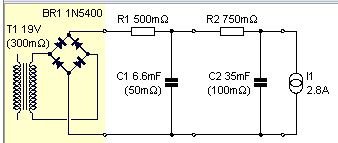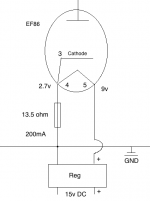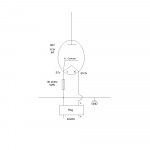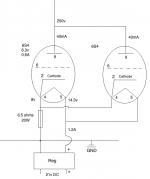POST: http://www.diyaudio.com/forums/tubes-valves/38248-new-dht-heater-62.html#post3581062
I'd like to get some feedback about the improvement to the sound when connecting the regulator this way. That is positive (Filament+) terminal connect to the cathode resistor. It will help me decide what to do with some problems I have with using LED bias for the 3C24. It is approx -6 volts bias but hooking the regulator this way means using double the number of LEDs which increases problems with common mode noise being picked up by wiring and getting onto the cathode and getting amplified.
Thanks,
Adrien.
Åke, if you are using Coleman Regulators, please connect the cathode resistor to the positive (Filament+) terminal.
The instructions are found in the the PDF document ANdht01, page 10. There's a connexion drawing and directions.
I'd like to get some feedback about the improvement to the sound when connecting the regulator this way. That is positive (Filament+) terminal connect to the cathode resistor. It will help me decide what to do with some problems I have with using LED bias for the 3C24. It is approx -6 volts bias but hooking the regulator this way means using double the number of LEDs which increases problems with common mode noise being picked up by wiring and getting onto the cathode and getting amplified.
Thanks,
Adrien.
Difficult to quantify sound improvement - but I can say this: A Coleman Regulator applied in a Filament Bias Regime (that is: a low-value cathode-resistor, which carries the whole filament current, so that the resistor becomes low enough that a bypass-capacitor is not required) - in this Regime the negative end of the filament must be connected to the resistor - or else the bias will be the wrong polarity.
Makers trying this out amps built like this certainly have no complaint about sound quality.
What I am saying: the bias method is more important to the sound than which end of the filament returns the anode-current to "ground".
Makers trying this out amps built like this certainly have no complaint about sound quality.
What I am saying: the bias method is more important to the sound than which end of the filament returns the anode-current to "ground".
Difficult to quantify sound improvement - but I can say this: A Coleman Regulator applied in a Filament Bias Regime (that is: a low-value cathode-resistor, which carries the whole filament current, so that the resistor becomes low enough that a bypass-capacitor is not required) - in this Regime the negative end of the filament must be connected to the resistor - or else the bias will be the wrong polarity.
...
So if I understand correctly then I have it hooked up wrong. For the 3C24 with LED bias I should have the regulator negative connected to the filament leg connected to the LEDs which are connected to ground.
The same holds true for the GM70 which is fixed bias but using a 10 ohm sense resistor. I should have the regulator negative connected to the filament leg connected to the 10 ohm which is connected to ground.
Thanks,
Adrien.
Great article from Vinylsavor on filament bias concept http://vinylsavor.blogspot.com/2012/03/filament-bias-part-1-concept.html
I did not know you could bias a tube this way until today. Thanks for sending the link Yagoolar.
Rod, I now understand much better what I need to do. Thanks for your help.
Adrien.
Rod, I now understand much better what I need to do. Thanks for your help.
Adrien.
Adrien, With Filament Bias, you can only use the Filament negative terminal to connect with the bias resistor. Think about the (conventional) current flow direction of the filament current, to see why. (draw arrows on the circuit, and consider that the cathode must be more positive than the grid).
With LED-, auto-, or fixed- bias, you can choose negative or positive- because only the anode-current is involved, and this always heads in the right direction!
BTW, you can use a Coleman Regulator to provide 30V or more of filament bias (best restricted to low filament-current triodes). There's one resistor to select, for high voltage operation. Filament Bias with 4P1L (15-25V bias) works very well.
The Regulator can be used to "Filament"-bias indirectly-heated valves, using the same method..... the ultra-low noise of the Regulator means that the bias quality is better than most other methods, and certainly better than autobias-with-electrolytic bypass capacitor.
With LED-, auto-, or fixed- bias, you can choose negative or positive- because only the anode-current is involved, and this always heads in the right direction!
BTW, you can use a Coleman Regulator to provide 30V or more of filament bias (best restricted to low filament-current triodes). There's one resistor to select, for high voltage operation. Filament Bias with 4P1L (15-25V bias) works very well.
The Regulator can be used to "Filament"-bias indirectly-heated valves, using the same method..... the ultra-low noise of the Regulator means that the bias quality is better than most other methods, and certainly better than autobias-with-electrolytic bypass capacitor.
Can anybody have eagle files of Rods Coleman dht filament supply? I can run it at 10v 5A output? Im searching filament supply for QB2/250 tube. Thanks for help.
Eagle files? I should hope not.
The design moved on from this primitive state, and it added fine adjustment, temperature compensation, and massively-improved noise-rejection. Finally, it became a self-assembly DIY kit, available at a friendly price.
And yes, 10V 5A is a standard configuration.
Send me some email, to have details (click my name).
The design moved on from this primitive state, and it added fine adjustment, temperature compensation, and massively-improved noise-rejection. Finally, it became a self-assembly DIY kit, available at a friendly price.
And yes, 10V 5A is a standard configuration.
Send me some email, to have details (click my name).
Stereo PP DHT
Rod, I'm in the final throes of planning a stereo PP 2A3 amp. Currently planning fixed bias and currently own a 2.5V x 10A transformer.
Tempted to ditch that for 4 individual heater transformers (so I can monitor bias current properly).
I've looked through a large number of postings and am still a little confused - are either of these architectures compatible with your heater supply?
And yes, 10V 5A is a standard configuration.
Rod, I'm in the final throes of planning a stereo PP 2A3 amp. Currently planning fixed bias and currently own a 2.5V x 10A transformer.
Tempted to ditch that for 4 individual heater transformers (so I can monitor bias current properly).
I've looked through a large number of postings and am still a little confused - are either of these architectures compatible with your heater supply?
Yes, moving to separate transformers is better if the anode current is returned (to Ground/0V) through a separate circuit.
But if you would like to monitor current through 1 ohm resistors (only), you can use 2 transformers, and 4 regulators - and get the highest possible quality of sound.
Details of the transformers, dc voltages etc are given in the PDF documents for the 2A3 Regulators - please click my name to send some email for these.
But if you would like to monitor current through 1 ohm resistors (only), you can use 2 transformers, and 4 regulators - and get the highest possible quality of sound.
Details of the transformers, dc voltages etc are given in the PDF documents for the 2A3 Regulators - please click my name to send some email for these.
With Filament Bias, you can only use the Filament negative terminal to connect with the bias resistor.
The Regulator can be used to "Filament"-bias indirectly-heated valves, using the same method.....
Rod Coleman
Rod when you bias a IDHT like this do you also connect the cathode to the same
negative terminal of the filament where the cathode resistor is connected , or it does not matter to what end of the filament the cathode is connected?
Say in case of a triode connected EF86 cathode pin3 is connected to filament pin4 and to bias resistor 13.5 ohms which goes to ground.
The other end of the filament pin5 is supplied with 9 volts to supply the filament current of 200mA and generate a filament bias of 2.7 volts at the cathode.
Do I understand correct ?
The Regulator can be used to "Filament"-bias indirectly-heated valves, using the same method.....
Rod Coleman
Rod when you bias a IDHT like this do you also connect the cathode to the same
negative terminal of the filament where the cathode resistor is connected , or it does not matter to what end of the filament the cathode is connected?
Say in case of a triode connected EF86 cathode pin3 is connected to filament pin4 and to bias resistor 13.5 ohms which goes to ground.
The other end of the filament pin5 is supplied with 9 volts to supply the filament current of 200mA and generate a filament bias of 2.7 volts at the cathode.
Do I understand correct ?
Srian, that is correct.
If you have a very low-noise current source, this biassing method works very well with low-heater-current IDHTs, certainly better than electrolytic caps for bypassing.
Don't use a LM317, or you will hear it!
If you have a very low-noise current source, this biassing method works very well with low-heater-current IDHTs, certainly better than electrolytic caps for bypassing.
Don't use a LM317, or you will hear it!
Just like that, Andy.
I have used this method for indirectly heated driver valves, and it certainly works better than electrolytic caps!
I have used this method for indirectly heated driver valves, and it certainly works better than electrolytic caps!
You could use it for the output stage, as I do with my 4P1L PSE amp, but some tubes work a lot better than others. Here's an 807 which is at the limits of what you'd consider doing. You do eliminate the cathode bypass, and since they are usually poison to the sound that might be worth doing if you can put up with the rather wasteful filament supply. But by the time you use an IDHT you might as well use a DHT.
Attachments
Using the 6S4A triode you'd get somewhere like the same operating conditions as a couple of 4P1L. I doubt if the sound would be as good, but you would benefit from a mu of 16.5 instead of 10. I actually have PPP 6S4As in the output of my old Leak Stereo 20. One day I'll replace them with 4P1Ls!
Attachments
I am also using filament bias with 3C24 at 6V and 3A. The bias developed across 2 ohm resistor.
Adrien.
Adrien.
Adrian, what are your transformer specifications?
I'm thinking about Rod's reg and filament bias for the 3c24 project I'm building.
I'm thinking about Rod's reg and filament bias for the 3c24 project I'm building.
Adrien, what are your transformer specifications?
I'm thinking about Rod's reg and filament bias for the 3c24 project I'm building.
I used Hammond 185F20 130VA 20V 6.5A. The design allowed me to remove some of the secondary windings to adjust the voltage down to what I needed. These make a bit of mechanical noise and run hot at 70 deg C so I am sure there are better transformers available. At approximately 113Vac line I got approximately 21Vac out with the load. I reduced the AC out to 19Vac. Of course your filter will also determine what AC voltage is required.

Member
Joined 2009
Paid Member
- Home
- Amplifiers
- Tubes / Valves
- New DHT heater


